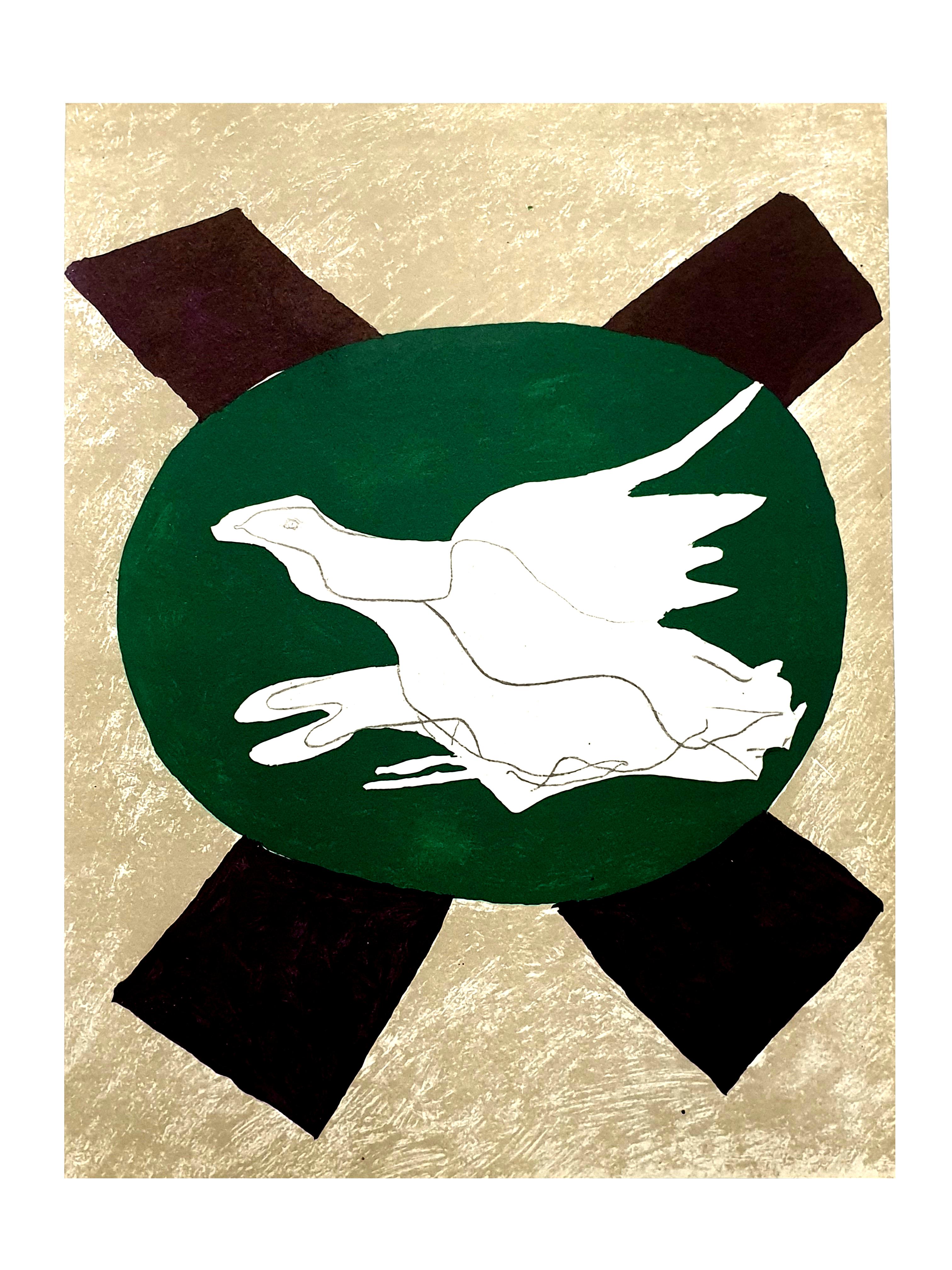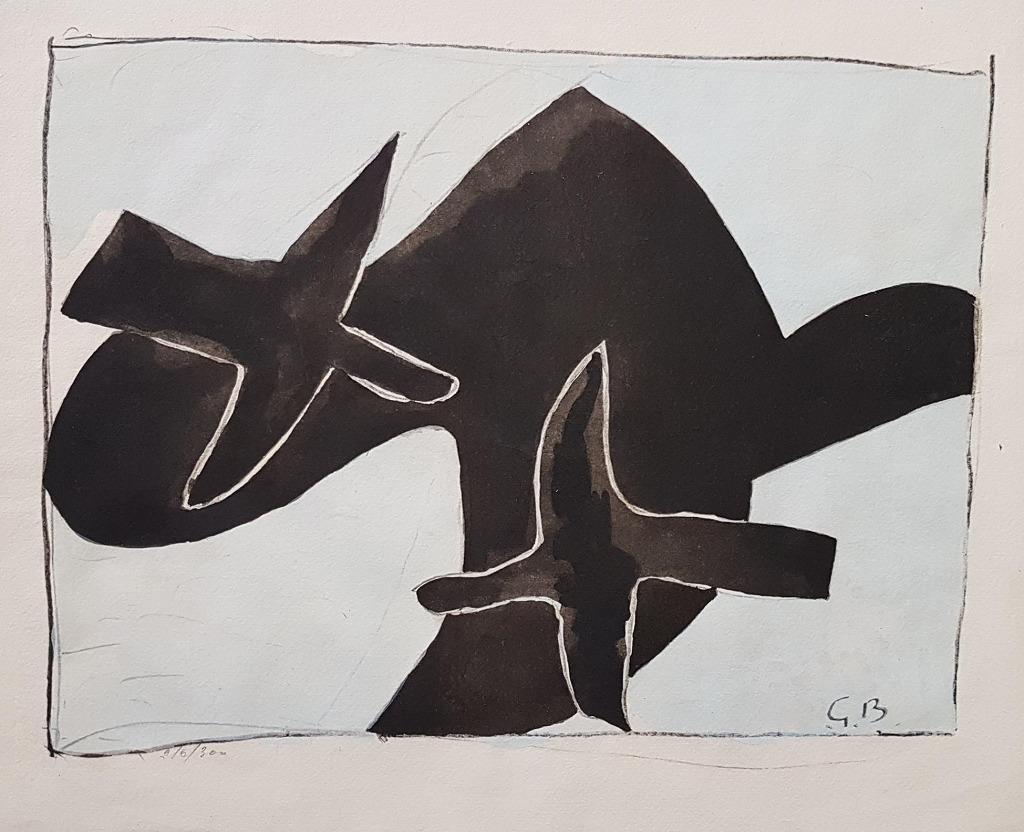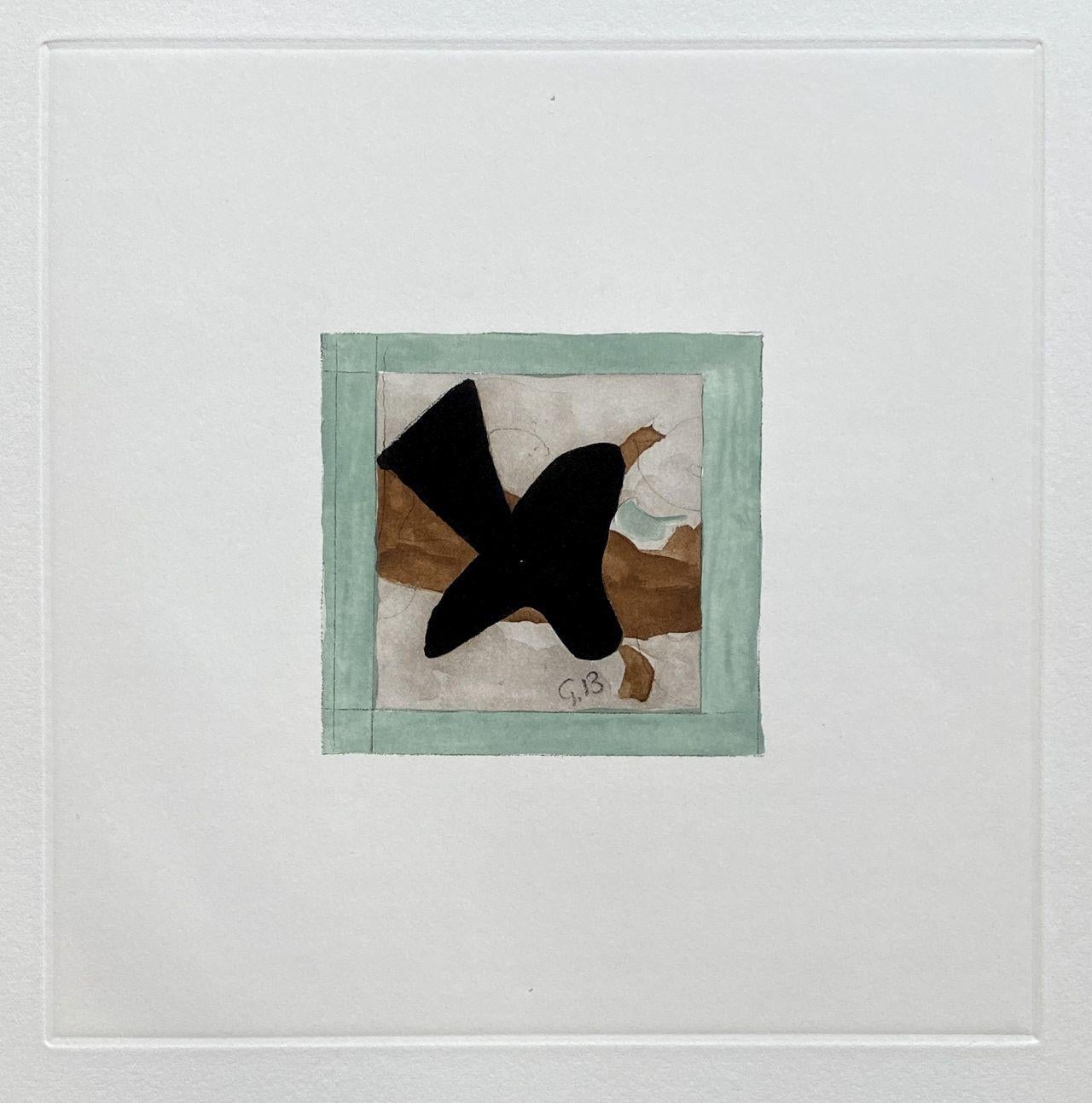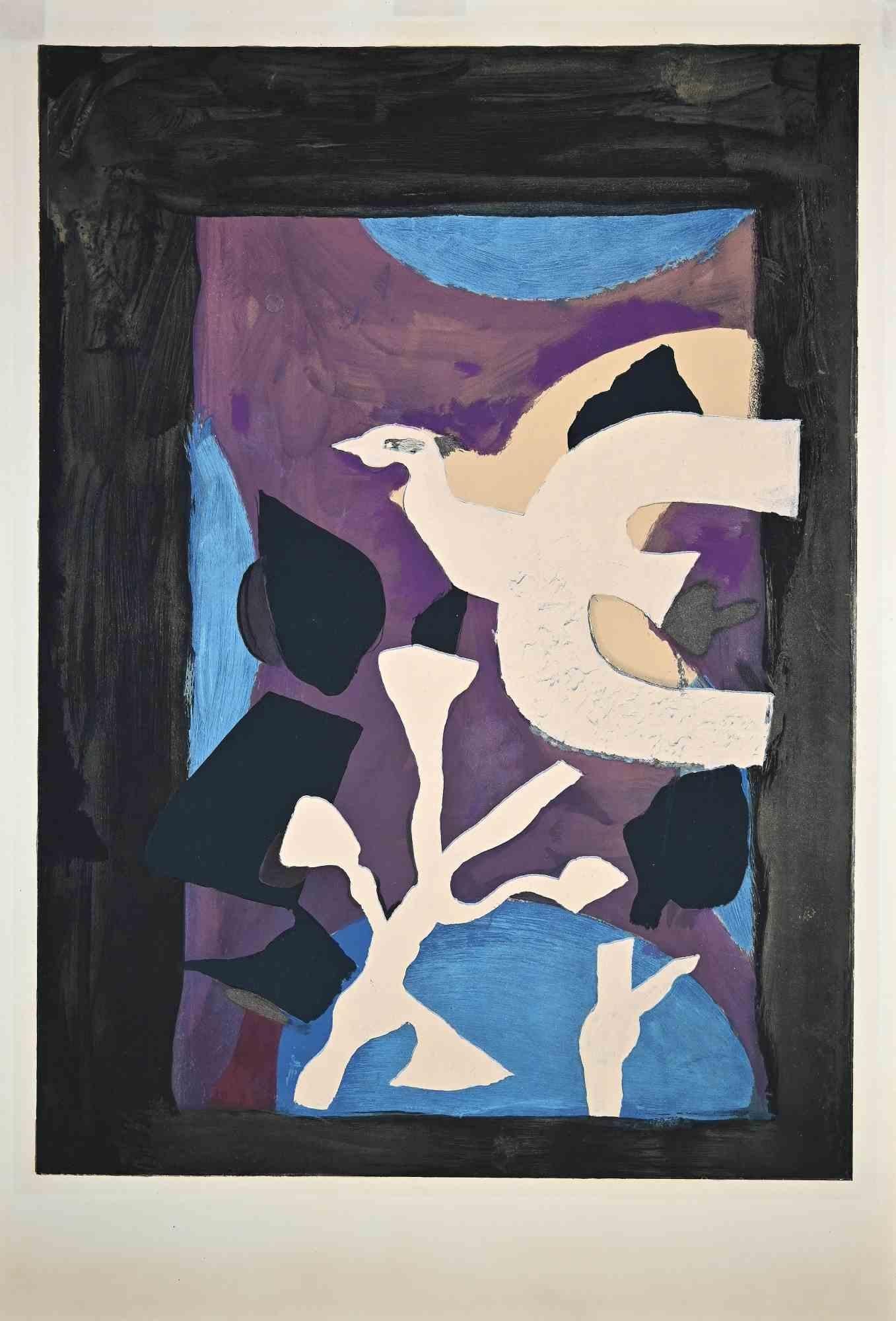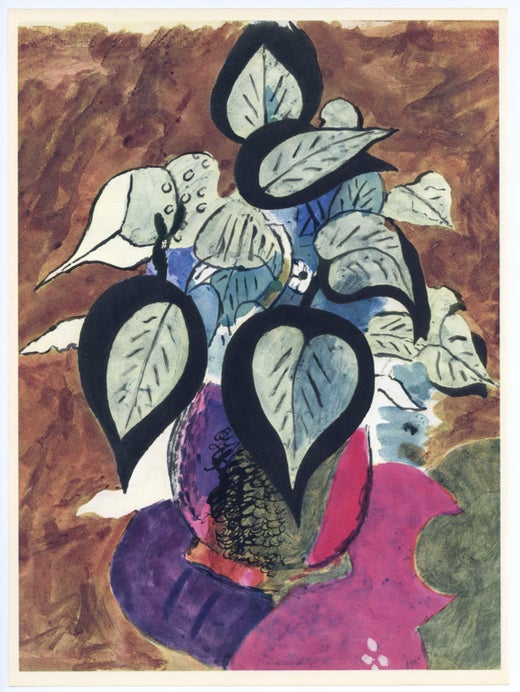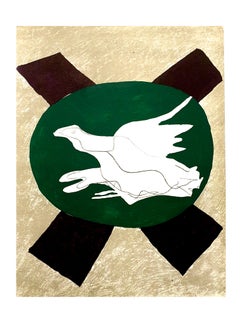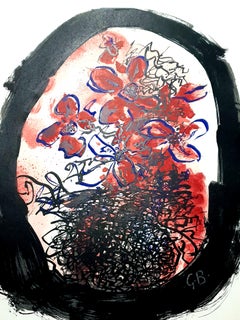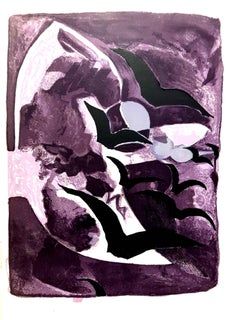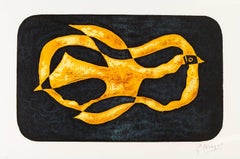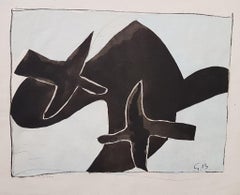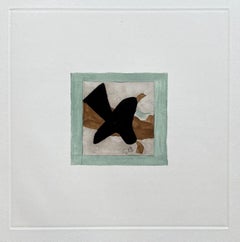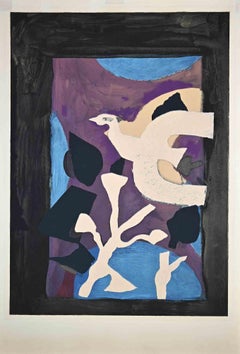Items Similar to The Bird - Lithograph
Want more images or videos?
Request additional images or videos from the seller
1 of 7
(after) Georges BraqueThe Bird - Lithograph1965
1965
$1,761.78
£1,345.06
€1,500
CA$2,487.51
A$2,729.73
CHF 1,425.75
MX$32,637
NOK 18,059.69
SEK 16,844.06
DKK 11,426.96
About the Item
Title: The Bird
Printed signature
Dimensions: 38 x 28 cm
from the edition of 250 as issued in Warnod, Andre, "Les Peintres mes amis" (Paris: Les Heures Claires, 1965)
The father of Cubism
Three Cubist that distinguishes art historian periods were initiated and developed by Georges Braque: The Cubist Cézanne (1907-1909), Executive (1909-1912) and synthetic (1912-1922).
Post-Impressionist and fawn, Braque no longer adheres to the contingency of a decorative way or the other. Cézanne’s paintings exhibited at the Grand Palais during the retrospective of 1907 are a revelation: Cézanne sought and invented a pictorial language. In his footsteps, Braque went to the South with the reasons of the Master. He returned with Estaque landscapes and surprising Ciotat it keeps Cezanne geometric model and retains the “passages” continuity from one surface to another to create the sensation of “turning around” of the object represented. But he wants to go after the consequences of the vision of Cezanne. In his paintings Houses in L’Estaque (1908) it simplifies the volumes of houses, neglects detail by removing doors and windows: the plastic rhythm that builds the table. Large Nude , a masterpiece of the period, can be considered the first work of Cézanne cubism .
Systematizing and deepening Braque discoveries open the door analytical cubism. In 1909, his painting became more cerebral than sensual. The pattern is recreated in the two-dimensionality of the canvas, leaving aside any illusionistic perspective. In Still Life with Violin, objects are analyzed facets according to their characteristic elements, each facet referring to a particular view of the object. There are so many facets of points selected view: Table reflects the knowledge of the object and the ubiquity of the eye. Moreover, Braque is looking for the essence of the objects in the world rather than their contingency, which explains the absence of light source and use of muted colors (gray, ocher), contingent aspects of the object . But formal logic has stepped facets, erased any anecdote to the object and ultimately led to his painting a hermetic more marked on the edge of abstraction (see the series of Castle Roche-Guyon ).
Braque, anxious to keep the concrete and refusing at all costs that the logic of Cubism takes the paintings to abstract, reintroduced signs of reality in his paintings in 1912 marks the beginning of Synthetic Cubism. Historians speak of “signs of real” rather than reality because what interests Braque, this is not to put reality into a table, but to create a painting which, by its language, refers to the real. To do this, he invented two major techniques XX th century inclusions and contributions. The inclusions consist of painting objects that have no real depth, materials (wallpaper in Nature morte aux playing cards faux wood is a pictorial inclusion) or letters (calligraphic inclusion in Portuguese ), made first brush and a few months later stencil. Contributions are defined in contrast with the collage on canvas of foreign materials: glued or sand paper, sawdust, etc.. Regarding the collages, Braque used for the first time in September 1912 a piece of adhesive paper imitating faux wood Compote and Glass , then the packet envelope of tobacco Bock in 1912-1913, or an advertisement in Damier , 1913). Inputs and inclusions refer to an external object in the table, without “emulate” this object. Away from their appearances, objects are represented in closest essence of the objects in the real world sense.
This is also the time of Synthetic Cubism that Braque invented paper sculpture. There are, unfortunately, and no one is living proof of a photograph makes it possible to realize: Paper and paperboard.
Métamorphoses period(1961-1963).
In 1961, Georges Braque worked on a Greek head for the Louvre, which obsesses him, and he wishes to free his mind. He tried several times to bring out the paint and the result was unsatisfactory. He thinks the ultimate metamorphosis its Greek head projected in three dimensions. He calls in his studio of Baron Heger Loewenfeld, master lapidary, and he communicates his enthusiasm during the “fateful encounter.” Nine months later, in honor of the eighty years of Georges Braque, Heger Loewenfeld offers the Master of the ring Circe: the famous Greek head finally exorcised, carved in an onyx. Braque Loewenfeld then asked to identify other issues that haunt him.
From dated and signed by Georges Braque, Heger gouaches Loewenfeld shapes works in the fields of jewelery, lapidary art, sculpture and etrog.
In September 1962, Heger of Loewenfeld and André Malraux meet the Ministry of Cultural Affairs. The two men share their impressions of aesthetes around the cabinet precious sculptures presented by Baron. Malraux, fascinated, considers that dealing with “the apotheosis of Braque” and orders on the field that show these masterpieces he calls the “jewels” to be organized at the earliest.
March 1963, the exhibition “Bijoux de Braque” opens in the Louvre, Pavillon Marsan. It is a success, and the exposure is prolonged until mid-May.
While “Jewelry Braque” travel on the France towards New York, Georges Braque off August 31, 1963. For thirty years, Heger Loewenfeld present collection of millions of enthusiastic spectators worldwide.
At the death of Loewenfeld Heger, Armand Israel succeeded him.
Georges Braque – his life (1882-1963)
1882 (May 13): Born in Argenteuil. The grandfather Georges Braque has a painting business.
1890 : The Braque family moved to Le Havre. The father founded a painting business building.
1893 : If enrolled in evening classes of Fine Arts.
1899 Before finishing his studies, apprenticed to his father, then in a decorative painting contractor.
1900 : Continues his apprenticeship as a painter and decorator in Paris. Comes to drawing lessons from the municipal workshop Batignolles.
1901-1902 : Military service near Le Havre.
1902 : Moves to Montmartre and enrolled at the Académie Humbert.
1905 :’s Fauves at the Salon d’Automne.
1906 : First exposure XXII th Salon des Independants. From June 12 to September 11: trip to Antwerp with Friesz where he made his first paintings cats .
1907 : In XXIII th Salon des Independants (March), sells his paintings to art critic Wilhelm Uhde and Kahnweiler merchant of German origin. Continued his wild paintings La Ciotat with Friesz (May), L’Estaque (late September and again in October and November). Between gradually into contact with Picasso.
1908 : Third stay at L’Estaque (end of May). The Salon d’Automne refuses paintings made by Braque, the truly innovative style. Kahnweiler them immediately accepts and organizes the first solo exhibition of the artist. The catalog is prefaced by Apollinaire. The critic Louis Vauxcelles discovers “cubes”: the birth of cubism .
Together more closely with Picasso, almost daily, Braque compared to a “mountain climber.”
1912 : Moves with Octavia (known Marcelle) Lapré. Spends the summer with Picasso in Avignon. Signed his first contract with Kahnweiler (November).
1914 : Mobilized. Kahnweiler gallery is taken as “property belonging to the enemy,” with all Cubist Braque paintings.
1915 : Injured, Braque trepanated
1916 : Discharged, he returned in Avignon
1917 : Start writing his Notebook Publishes “Thoughts and reflections on the painting” in the North-South magazine . Sign a contract with the dealer Léonce Rosenberg.
1918 : Starts his drawings Diaries.
1919 : Expose gallery in The Effort Moderne Léonce Rosenberg.
1921 : Selling his paintings belonging to the receiver Kahnweiler. At the Hotel Drouot, boxing Léonce Rosenberg, whom he accuses of selling his paintings at a low price.
1923 : The last fires were extinguished Cubism, Braque looking for a new breath. Sign a contract with the art dealer Paul Rosenberg.
1925 : Moves in her new house and studio built by Auguste Perret, near the Parc Montsouris in Paris.
1926 (14 November): Wife Octavia Lapré to Paris in 14 th district.
1929 : In fact develop a home-workshop Varengeville-sur-Mer, Normandy.
During the Occupation , is in Paris.
1947 is the new dealer Aimé Maeght.
1948 : Grand Prix for Painting at the Biennale in Venice. Maeght publish editions Notebook Georges Braque (1917-1947).
1953 : Braque realizes the ceiling of the Louvre Henri II room.
1954 : Decoration Mas Bernard Saint-Paul-de-Vence. Creating windows for the church of Varengeville. Interview with Dora Vallier in the journal Cahiers d’art.
1960 : Exhibition of his graphic work at the National Library.
1961 : Exhibition Workshop Braque at the Louvre. Meet Heger of Loewenfeld.
1963 : Exhibition Jewelry Braque , the Museum of Decorative Arts (March-May). Death (August 31) while the collection “Les Bijoux de Braque” come to New York aboard the ship France . Funeral Oration in front of the colonnade of the Louvre, pronounced by André Malraux, Minister of State for Cultural Affairs and broadcast on ORTF (September 3). Burial in the marine cemetery Varengeville-sur-Mer (September 4).
- Creator:(after) Georges Braque (1882 - 1963, French)
- Creation Year:1965
- Dimensions:Height: 14.97 in (38 cm)Width: 11.03 in (28 cm)Depth: 0.04 in (1 mm)
- Medium:
- Movement & Style:
- Period:
- Condition:
- Gallery Location:Collonge Bellerive, Geneve, CH
- Reference Number:1stDibs: LU16122412413
(after) Georges Braque
Braque began his artistic career painting in a Fauvist style, strongly influenced by friends Raoul Dufy and Henri Matisse. In 1907, however, after befriending Pablo Picasso, Braque began focusing on Cubist compositions and a more muted color palette. He and Picasso would work closely until 1914 when Picasso began focusing on symbolism and portraiture, while Braque sought to explore “pure composition” void of meaning and symbolism. A 1922 exhibition at the Salon d’Automne in Paris launched Braque further into fame. He won several important prizes over the next few decades, including First Prize at the Carnegie International and the main prize for painting at the Venice Biennale. In 1961, Braque became the first living artist to ever have his work displayed at The Louvre. Throughout the 1930s and 40s, Braque created many works featuring Greek and Roman mythological imagery such as this print, though his hope was to use the images simply as visual objects stripped of their histories, lore, and symbolism.
About the Seller
4.9
Gold Seller
Premium sellers maintaining a 4.3+ rating and 24-hour response times
Established in 2015
1stDibs seller since 2015
969 sales on 1stDibs
Typical response time: 1 hour
- ShippingRetrieving quote...Shipping from: Collonge Bellerive, Geneve, Switzerland
- Return Policy
More From This Seller
View AllGeorges Braque - Birds - Original Lithograph
By Georges Braque
Located in Collonge Bellerive, Geneve, CH
Georges Braque - Birds - Original Lithograph
Published in the deluxe art review, XXe Siecle
1958
Dimensions: 32 x 24 cm
Publisher: G. di San Lazzaro.
Unsigned and unumbered as issued
Category
1950s Modern Figurative Prints
Materials
Lithograph
Georges Braque - Original Lithograph
By Georges Braque
Located in Collonge Bellerive, Geneve, CH
Georges Braque - Original Lithograph
1963
Dimensions: 32 x 24 cm
Andre Sauret, Monte Carlo
The father of Cubism
Three Cubist that distinguishes art historian periods were initiated and developed by Georges Braque: The Cubist Cézanne (1907-1909), Executive (1909-1912) and synthetic (1912-1922).
Post-Impressionist and fawn, Braque no longer adheres to the contingency of a decorative way or the other. Cézanne’s paintings exhibited at the Grand Palais during the retrospective of 1907 are a revelation: Cézanne sought and invented a pictorial language. In his footsteps, Braque went to the South with the reasons of the Master. He returned with Estaque landscapes and surprising Ciotat it keeps Cezanne geometric model and retains the “passages” continuity from one surface to another to create the sensation of “turning around” of the object represented. But he wants to go after the consequences of the vision of Cezanne. In his paintings Houses in L’Estaque (1908) it simplifies the volumes of houses, neglects detail by removing doors and windows: the plastic rhythm that builds the table. Large Nude , a masterpiece of the period, can be considered the first work of Cézanne cubism .
Systematizing and deepening Braque discoveries open the door analytical cubism. In 1909, his painting became more cerebral than sensual. The pattern is recreated in the two-dimensionality of the canvas, leaving aside any illusionistic perspective. In Still Life with Violin, objects are analyzed facets according to their characteristic elements, each facet referring to a particular view of the object. There are so many facets of points selected view: Table reflects the knowledge of the object and the ubiquity of the eye. Moreover, Braque is looking for the essence of the objects in the world rather than their contingency, which explains the absence of light source and use of muted colors (gray, ocher), contingent aspects of the object . But formal logic has stepped facets, erased any anecdote to the object and ultimately led to his painting a hermetic more marked on the edge of abstraction (see the series of Castle Roche-Guyon ).
Braque, anxious to keep the concrete and refusing at all costs that the logic of Cubism takes the paintings to abstract, reintroduced signs of reality in his paintings in 1912 marks the beginning of Synthetic Cubism. Historians speak of “signs of real” rather than reality because what interests Braque, this is not to put reality into a table, but to create a painting which, by its language, refers to the real. To do this, he invented two major techniques XX th century inclusions and contributions. The inclusions consist of painting objects that have no real depth, materials (wallpaper in Nature morte aux playing cards faux wood is a pictorial inclusion) or letters (calligraphic inclusion in Portuguese ), made first brush and a few months later stencil. Contributions are defined in contrast with the collage on canvas of foreign materials: glued or sand paper, sawdust, etc.. Regarding the collages, Braque used for the first time in September 1912 a piece of adhesive paper imitating faux wood Compote and Glass , then the packet envelope of tobacco Bock in 1912-1913, or an advertisement in Damier , 1913). Inputs and inclusions refer to an external object in the table, without “emulate” this object. Away from their appearances, objects are represented in closest essence of the objects in the real world sense.
This is also the time of Synthetic Cubism that Braque invented paper sculpture. There are, unfortunately, and no one is living proof of a photograph makes it possible to realize: Paper and paperboard.
Métamorphoses period(1961-1963).
In 1961, Georges Braque worked on a Greek head for the Louvre, which obsesses him, and he wishes to free his mind. He tried several times to bring out the paint and the result was unsatisfactory. He thinks the ultimate metamorphosis its Greek head projected in three dimensions. He calls in his studio of Baron Heger Loewenfeld, master lapidary, and he communicates his enthusiasm during the “fateful encounter.” Nine months later, in honor of the eighty years of Georges Braque, Heger Loewenfeld offers the Master of the ring Circe: the famous Greek head finally exorcised, carved in an onyx. Braque Loewenfeld then asked to identify other issues that haunt him.
From dated and signed by Georges Braque, Heger gouaches Loewenfeld shapes works in the fields of jewelery, lapidary art...
Category
1960s Modern Figurative Prints
Materials
Lithograph
After Georges Braque - Les oiseaux de nuit - Lithograph
By Georges Braque
Located in Collonge Bellerive, Geneve, CH
Georges Braque - Les oiseaux de nuit
Lithograph after the gouache
1964
Dimensions: 30 x 20 cm
Edition of 200 (one of the 200 on Vélin de Rives)
Mourlot Pre...
Category
1960s Modern Abstract Prints
Materials
Lithograph
After Georges Braque - Antiborée - Lithograph
Located in Collonge Bellerive, Geneve, CH
Lithograph after Georges Braque.
Signed in the plate
Edition of 150
Dimensions: 76 x 117 cm
Bibliography:
« Les Métamorphoses de Braque» of Heger de Loewenfeld and Raphaël de Cuttoli , Editions FAC, Paris, 1989.
In 1961 Georges Braque decided with his laidary friend Heger de Loewenfeld to pick up certain of his works to in order to create artworks, this beautiful litograph is one of them.
Héméra in the Mythology:
In Greek mythology Hemera was the personification of day and one of the Greek primordial deities. She is the goddess of the daytime and, according to Hesiod, the daughter of Erebus and Nyx (the goddess of night). Hemera is remarked upon in Cicero's De Natura Deorum, where it is logically determined that Dies (Hemera) must be a god, if Uranus is a god. The poet Bacchylides states that Nyx and Chronos are the parents, but Hyginus in his preface to the Fabulae mentions Chaos as the mother/father and Nyx as her sister.
She was the female counterpart of her brother and consort, Aether (Light), but neither of them figured actively in myth or cult. Hyginus lists their children as Uranus, Gaia, and Thalassa (the primordial sea goddess), while Hesiod only lists Thalassa as their child.
The father of Cubism
Three Cubist that distinguishes art historian periods were initiated and developed by Georges Braque: The Cubist Cézanne (1907-1909), Executive (1909-1912) and synthetic (1912-1922).
Post-Impressionist and fawn, Braque no longer adheres to the contingency of a decorative way or the other. Cézanne’s paintings exhibited at the Grand Palais during the retrospective of 1907 are a revelation: Cézanne sought and invented a pictorial language. In his footsteps, Braque went to the South with the reasons of the Master. He returned with Estaque landscapes and surprising Ciotat it keeps Cezanne geometric model and retains the “passages” continuity from one surface to another to create the sensation of “turning around” of the object represented. But he wants to go after the consequences of the vision of Cezanne. In his paintings Houses in L’Estaque (1908) it simplifies the volumes of houses, neglects detail by removing doors and windows: the plastic rhythm that builds the table. Large Nude , a masterpiece of the period, can be considered the first work of Cézanne cubism .
Systematizing and deepening Braque discoveries open the door analytical cubism. In 1909, his painting became more cerebral than sensual. The pattern is recreated in the two-dimensionality of the canvas, leaving aside any illusionistic perspective. In Still Life with Violin, objects are analyzed facets according to their characteristic elements, each facet referring to a particular view of the object. There are so many facets of points selected view: Table reflects the knowledge of the object and the ubiquity of the eye. Moreover, Braque is looking for the essence of the objects in the world rather than their contingency, which explains the absence of light source and use of muted colors (gray, ocher), contingent aspects of the object . But formal logic has stepped facets, erased any anecdote to the object and ultimately led to his painting a hermetic more marked on the edge of abstraction (see the series of Castle Roche-Guyon ).
Braque, anxious to keep the concrete and refusing at all costs that the logic of Cubism takes the paintings to abstract, reintroduced signs of reality in his paintings in 1912 marks the beginning of Synthetic Cubism. Historians speak of “signs of real” rather than reality because what interests Braque, this is not to put reality into a table, but to create a painting which, by its language, refers to the real. To do this, he invented two major techniques XX th century inclusions and contributions. The inclusions consist of painting objects that have no real depth, materials (wallpaper in Nature morte aux playing cards faux wood is a pictorial inclusion) or letters (calligraphic inclusion in Portuguese ), made first brush and a few months later stencil. Contributions are defined in contrast with the collage on canvas of foreign materials: glued or sand paper, sawdust, etc.. Regarding the collages, Braque used for the first time in September 1912 a piece of adhesive paper imitating faux wood Compote...
Category
1950s Cubist Animal Prints
Materials
Lithograph
Lithograph after Georges Braque
Located in Collonge Bellerive, Geneve, CH
Lithograph after Georges Braque
From the deluxe art review, Derrière le Mirroir
1964
Printed signature
Dimensions: 38 x 28 cm
DLM No. 148, 1964
Edition: Foundation Maeght at Saint P...
Category
1960s Modern Figurative Prints
Materials
Lithograph
After Georges Braque - Oiseaux - Pochoir
By Georges Braque
Located in Collonge Bellerive, Geneve, CH
after Georges Braque
Oiseaux
Color Pochoir on Paper
Published in the deluxe art review, XXe Siecle (issue number 11 "Les nouveaux rapports de l'art et de la nature")
1958
Dimensions:...
Category
1950s Modern Figurative Prints
Materials
Stencil
You May Also Like
The Black Birds - Lithograph After Georges Braque - 1958
By (after) Georges Braque
Located in Roma, IT
The Black Birds is a lithograph published by Maeght after an original composition by Georges Braque in 1958. Braque authorized and selected certain works to be reproduced by his tru...
Category
1950s Contemporary Abstract Prints
Materials
Lithograph
Black Birds - Lithograph - 1956
By (after) Georges Braque
Located in Paris, IDF
(after) Georges Braque, (1882 - 1963)
Les Oiseaux Noirs (Black Birds), 1956
Lithograph
Printed in Jacomet workshop
On vellum 40 x 48 cm (c. 16 x 19 inc...
Category
1950s Cubist Figurative Prints
Materials
Lithograph
The Bird - Etching Signed in the Plate - 1965 (Orozco #783)
By George Braque
Located in Paris, IDF
Georges Braque
The bird
Etching in colors (Crommelynck workshop)
Signed in the plate with the monogram
Edition of 250 copies not numbered
On Arches vellum 38 x 28 cm (c. 15 x 11 in...
Category
1960s Modern Abstract Prints
Materials
Etching
Oiseaux - Lithograph after Georges Braque - Mid-20th Century
By (after) Georges Braque
Located in Roma, IT
Oiseaux is an lithograph realized by an anonymous artist after Georges Braque in the 20th Century.
Printed by Mourlot. Good conditions.
The artw...
Category
Mid-20th Century Cubist Figurative Prints
Materials
Lithograph
Leda and the Swann - lithograph - 399 copies
By (after) Georges Braque
Located in Paris, IDF
Georges BRAQUE
Leda and the Swann
Stone lithograph (Art-Litho workshop, Paris)
Printed signature in the pate
Limited to 399 copies unumbered
On Arches vellum 18 x 23" (45 x 58 cm)
E...
Category
Late 20th Century Cubist Animal Prints
Materials
Lithograph
Oiseau et Lotus - Lithograph by Georges Braque - 1963
By Georges Braque
Located in Roma, IT
Oiseau et Lotus is a color lithograph on paper, realized by the French Cubist artist, Georges Braque (1882-1963).
Printed by ARTE in 1963 by order of Galerie Maeght in Paris in a ci...
Category
1960s Modern Abstract Prints
Materials
Lithograph
More Ways To Browse
Mid Century Step End Tables
Mid Century Cube End Table
Geometrical Models
Wood Compote
Tarkay Giclee
Walter Lees
Warhol Margrethe
Warhol Playboy
Warhol Witch
Alex Katz Brisk Day
Alex Katz Ulla
Andre Level
Andy Warhol Birth Of Venus
Andy Warhol Greta Garbo
Andy Warhol Kachina Dolls 381
Andy Warhol Lenin
Andy Warhol Mata Hari
Andy Warhol Sitting Bull
